I’ll admit, when I started reading L.E. Modesitt’s The Magic of Recluce, I had no idea that I was only scratching the surface of the Saga of Recluce. The book lays out the central tenets of the series, presenting the ongoing battle for balance between chaos and order through the eyes of exile Lerris, but he is only one character over 19 books spanning nearly 2,000 years. Lerris’ story begins in the year 1850 and is just one (albeit very important) point on Recluce’s massive timeline. So many people came before him and established the physical and figurative boundaries of the Saga of Recluce—from founding the eponymous island to establishing the push-and-pull between white wizards and black mages.
Here’s your beginner’s guide to the settings that frame Modesitt’s saga, and the characters and civilizations that populate those magical lands. In an effort to keep this as spoiler-light as possible, most of the information is drawn from The Magic of Recluce—so, about as much knowledge as Lerris possesses—plus a little extra contextualization. The rest is up to you to discover as you read through.
First, a brief clarification: “Recluce” refers to both the entire saga as well as the island of Recluce, one of the five major landmasses making up this fantasy world. While Recluce’s history is about a thousand years shorter than the other countries that surround it, it plays a key role in the saga, as many characters pass through it or leave the isolated atmosphere of Recluce—based on a belief that order magic is better than chaos magic—to better understand the world around them. In later books, Modesitt flips the perspective by introducing protagonists from chaos magic-ruled Hamor and other countries previously depicted as antagonists, to explore how deep-seated prejudice colors one’s worldview, and to show that Recluce’s pro-order viewpoint isn’t all it’s cracked up to be.
Magic System
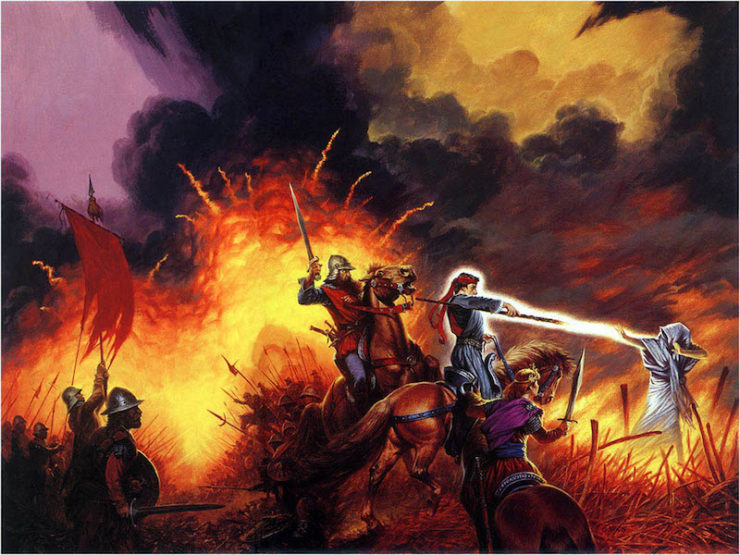
Chaos vs. Order
Modesitt’s rigorously defined magic system relies on the tenets of all matter being made up of order and chaos: the former existing in the molecular bonds that make up the structure of matter, the latter presented as the entropy that breaks down or destroys matter. Not only must magic users grasp their chosen side, but they must also understand how the two interact, as they are inextricably intertwined: creating more order also creates more chaos, and vice versa; if you limit chaos, you also limit order; and so forth. Fansite The Worlds of L.E. Modesitt, Jr. best sums up the push-and-pull between these two forces:
Everything that exists has both order and chaos in it, interacting with each other, with order trying to strengthen an object while chaos tries to weaken it. Chaos magic does exactly what you would think it would, destroy things, with disease, sickness, earthquakes, fire, explosions, et cetera. How a chaos master does this is by either manipulating chaos to break the order bonds within objects, or throwing pure chaos fire at them to burn them. Order masters do just the opposite, manipulating objects by strengthening or rearranging the order bonds within them. Chaos is represented by the color white, because white light is a chaotic mixture of all colors of light; order is represented by black, because it absent of all light, and thus pure and orderly. Order does not quite equate to good, nor does chaos equate fully to evil.
Furthermore, order and chaos are not separate, nor are they unlimited; they are indeed finite, and they must balance each other in equal quantities. Nature seeks this Balance, for it consists of both order and chaos, and too much of either would destroy it. If order or chaos get too powerful, the Balance between them must be righted; some of books deal with this idea. This fact gives rise to the idea of grey magicians, who work with both order and chaos and work to maintain the Balance between them.
White Wizards vs. Black Mages vs. Gray Wizards
In a storytelling sense, Modesitt wanted the subvert the trope of white being “good” and black being “evil” by switching up the connotations of these colors: black mages harness order, while white wizards unleash chaos. Then there are gray wizards, the rare individuals who can manipulate both order and chaos, though they avoid direct use of the latter as it is known to shorten one’s lifespan… though some gray wizards choose the identity of a druid and are able to prolong their existence by several lifetimes through magical means. Shadowed Blade has a fascinating deep dive into the mechanics of both sides.
As the first several books are from the perspective of Recluce’s pro-order belief system, there is a natural bias toward the black mages, who run the country from a variety of positions: the Institute, which debates decisions; the Brotherhood, which serves as the army and navy when it comes to dealing with outsiders; and so forth. However, one of the most fascinating aspects of Modesitt’s magic system is that most of its magic users are not solely mages—they’re tradesmen, using their magic for practical means. Order mages are more likely to be craftsmen: potters, carpenters, engineers, smiths. Some order mages also use their magic in agriculture and livestock, strengthening the existing bonds in crops and animals alike to improve their quality and even create new breeds. Chaos mages are more limited in their job options: Though more tend toward law enforcement, they can also contribute chaos magic toward improving quality of life through building roads, removing bacteria from water, and curtailing smuggling.
The World of Recluce
Not only is this map from the era of The Magic of Recluce, but the descriptions of the four continents and single island are all from the perspective of Recluce the island, the same viewpoint that the first several books follow. Operating under that somewhat biased perspective, here’s your guide to the world:
Recluce
An isolated island, Recluce fastidiously retains order by instilling in its citizens a culture of perfection and striving for perfection. However, the repetition of a job well done can become grating and dull for some members of society, like young Lerris. But boredom is dangerous, as one of his family members points out: “There is no place in Recluce for unfocused dissatisfaction … boredom, inability to concentrate, unwillingness to apply yourself to the fullest of your ability—these can all allow chaos a foothold in Recluce.” Citizens who are out of step with Recluce’s order must embark on the dangergeld, a ritualistic journey to learn more about the world before deciding if he will follow Recluce’s rules. Lerris chafes at the concept, complaining that “people seem to be punished or exiled from Recluce just because they don’t meet some unseen or unspoken standard.” But it goes both ways, according to another character in the novel: “By your actions and beliefs, you have chosen not to accept Recluce. Until you do, you are from Recluce, but not of Recluce.”
The first major spot on Lerris’ dangergeld is Nylan, which possesses a legendary reputation: “Nylan has always been the Black City, just as the forgotten Frven was once the White City. It doesn’t matter that Nylan has little more than a village’s population, or that it is a seaport used only by the Brotherhood. Or that it is a fortress that has never been taken, and tested but once. Nylan is the Black City, and it will always be that.”
Candar
The most chaotic of the major continents, due to its proximity to Recluce: There must be balance between Recluce’s need for order, which determines Candar’s inversely proportional characteristics. But for about 1,000 years before Recluce even had inhabitants, Candar was the site of the rise and fall of several civilizations. There was the Cyador army of invaders battling the natives of Candar; the matriarchal societies of Western Candar, concentrated in the city of Westwind, fending off attacks from the white wizards in the city-state of Fairhaven, who also control the male-dominated lands of Eastern Candar; and the “modern” Candar, ruled almost entirely by white wizards. The forgotten city of Frven was once the White City, but it perished.
Hamor
Almost as intimidating to Recluce inhabitants as Candar, though the Emperor of Hamor at the time of The Magic of Recluce (a former dangergelder) is known to enjoy some order. However, the “Empire of the East,” the oldest inhabited continent in this world, is still characterized as a place “where the lack of order leads to rebellions, oppression, and starvation.”
Nordla
One of the two northernmost continents (and therefore characterized by its cold weather), Nordla doesn’t get much attention until the books The Wellspring of Chaos and Ordermaster. Taking place 100 or so years before The Magic of Recluce, this storyline concerns resistance efforts between Nordla and Austra to keep both lands from being invaded by the Hamorian empire, which is ripe for expansion.
Austra
Nordla’s neighbor and Kharl’s adopted country. Home to traders who travel to the other stretches of the world in search of goods and adventures.
Figureheads
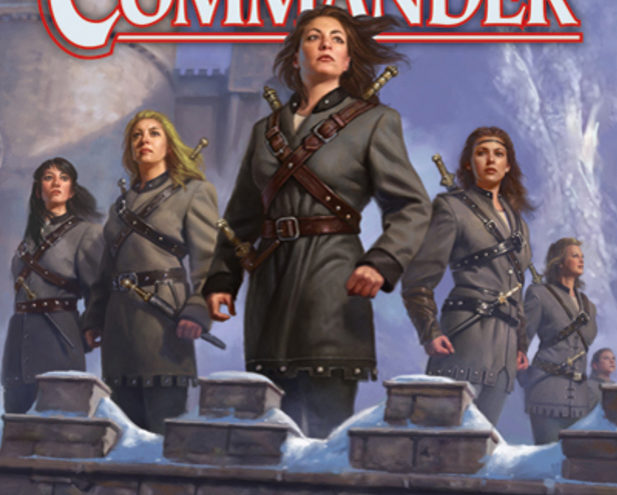
As the Saga of Recluce charts its own millennia-long history, characters shift from real-life figures into mythical ones, with their adventures elevated to the status of legends for their descendants and later civilizations. Most of these figureheads are male, though they are drawn to equally powerful women who play key roles in their stories—and then there’s the polarizing Saryn, above. Here are a couple of names to keep an eye out for.
Lerris
The protagonist of The Magic of Recluce and our way into this world. When an apprenticeship with his carpenter uncle does nothing to assuage Lerris’ dissatisfaction and—worse—boredom with his life, he is sent on the dangergeld to learn what his proper place within Recluce (or outside of it) is. We get a few hints of what his true calling might be when he is gifted a black staff and shows signs of an affinity for order magic before he even begins his journey. As he learns about the world outside of Recluce and uncovers secrets about his heritage, Lerris realizes that his dangergeld is very different from his peers’, and that he has a higher calling in the battle between chaos and order. While Lerris starts out with a fairly limited self-awareness, not to mention vocabulary—he disdains teachers who talk around issues and keeps referring to his annoying classmate Tamra as a bitch—once he starts to understand the vitality of his dangergeld he sheds his spoiled attitude and naïveté. Turns out all he needed was for the stakes to be high enough.
Krystal
While the reader would initially be tempted to dismiss Krystal, as Lerris seems to, for her giggle fits and odd prowess with her dinner knife, beneath the surface there is a blade-master as sharp as her namesake. Tamra may initially capture Lerris’ attention, but Krystal is the more fascinating potential partner. It shouldn’t surprise you that the girl known for meticulously slicing her apples with daggers becomes the head of an army. Yet despite her prowess as a military leader, Krystal still suffers a strange combination of envy and fear of her powerful partner, making her a sympathetic figure.
Justen
An order mage-turned-druid who learns how to harness both order and chaos while fighting the white wizard army in Candar. Studying this rare intersection of magics, Justen is able to unlock the secrets to a nigh-apocalyptic weapon that could end the war. By the time that Lerris meets him in The Magic of Recluce, Justen has become more of a mentor figure, guiding Lerris on his understanding of order and chaos… not to mention channeling Obi-Wan Kenobi due to his withholding of certain key information related to his young charge.
Creslin
An order mage from Candar who flees an arranged marriage in matriarchal Westwind, and ultimately leaves Candar by way of a marriage to the chaos wizard Megaera. The two land on an uninhabited island to the east of Candar, unintentionally founding Recluce. But as Creslin attempts to make Recluce habitable, his actions have unforeseen effects…
Megaera
Creslin’s betrothed and a powerful chaos wizard in her own right. While many Recluce novels concern characters who learn to develop a certain magic depending on which energy draws them, Megaera—who is known to throw chaos-fire when provoked—instead explores what it means to “switch sides” from chaos to order.
Kharl
While Kharl’s arc is not unlike Lerris’, he is the unlikelier hero, as his mage training is self-taught. A cooper, Kharl rescues a wounded blackstaffer; but after she is murdered, he comes into possession of her staff and the order mages’ sacred text, The Basis of Order, and is forced to learn an entirely new trade.
Saryn
The Arms-Commander of Westwind, Saryn plays a key role in both protecting her city and shaping the regency in neighboring lands like Lornth, while playing an integral part in the early history of the Recluce universe. A somewhat aloof narrator of her own story, Saryn’s impact is nonetheless felt for centuries to come, and her position in history debated: Was she a tyrant, or just a soldier? Did she bring about beneficial social change, or catalyze an irreversible cultural shift? Interestingly, the dedication on the first page of her novel Arms-Commander reads For all the women cursed as tyrants in getting the job done when their male counterparts are only considered tough.
Lorn
The man who began it all, in Year 1: officer of the White Empire of Cyador and secret magus Lorn provides insight into the white wizards. Centuries before hyper-ordered Recluce was even a speck in a wizard’s eye, Lorn and his people made the case for harnessing chaos to fight off barbarians and rival empires.
Timeline
As mentioned, the Saga of Recluce jumps back and forth in time over a period of 1,855 years; the world of Recluce and its surrounding continents are host to a number of different civilizations, some the result of invasions and others the evolved descendants of ancient cultures. Or, as Modesitt describes it:
In a way, the Recluce Saga is almost the novelized epic history of a world, but one told only through the lives of the characters, beginning with the rise and then the fall of a great empire—Cyador—followed by the rise and fall of other lands, through which history the use of the magic provided by the forces of order and chaos underlies the economic and political power of various lands.
Despite their differences in power structures—order or chaos dominant, men or women ruling—they share the overarching theme of consequences: Each civilization’s actions create ripple effects that shape the cultures and attitudes of the subsequent generations… just like any real-world history book.
Part of the appeal of reading the Saga of Recluce is discovering where the proverbial stones are dropped to create these far-reaching ripples. All we’ll say is that over those 1,855 years, you’ll encounter Angels; the army of Cyador versus the natives of Candar; female-dominated Westwind versus male-centric Eastern Candar; Fairhaven replacing Cyador; Demons following the Angels, 500 years later; the founding of Recluce, and everything that this little island sets into motion.
Because this history is nearly two millennia long, the books will often jump ahead hundreds of years. Though Magi’i of Cyador starts at what is considered year 1 of the Recluce universe, we spend time in the early 400s, a nice chunk from 900-1200, and several jaunts into the 1500s, 1600s, 1700s, and 1800s. Recluce: The Official L.E. Modesitt, Jr. Fan Site has constructed an excellent timeline that gives you an idea of each book’s place in Recluce’s chronology, along with quick (albeit spoilery) notes about the major happenings in each book. And from Wikipedia, the same timeline in chart form:
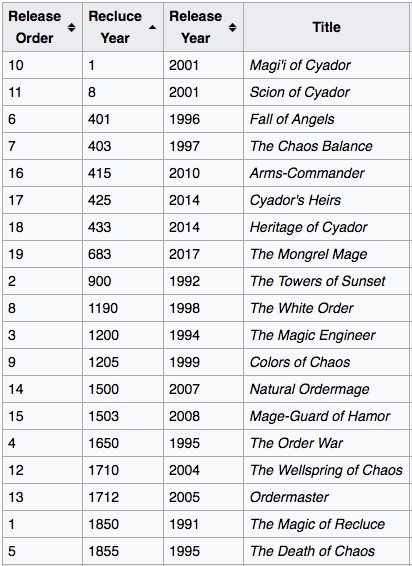
Now that you know the basics, you’re free to jump around in time and place! While many Saga of Recluce readers have chosen to read the books in publication order (rather than chronological), Modesitt says it’s the reader’s choice to read the books in either order, or neither, the only caveat being that one should read the first book of a certain character before going on to the second.
Natalie Zutter has been taking worldbuilding notes all throughout this piece. Read more of her work on Twitter and elsewhere.










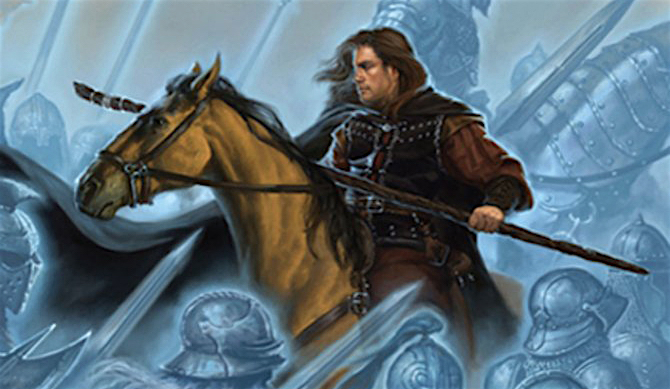
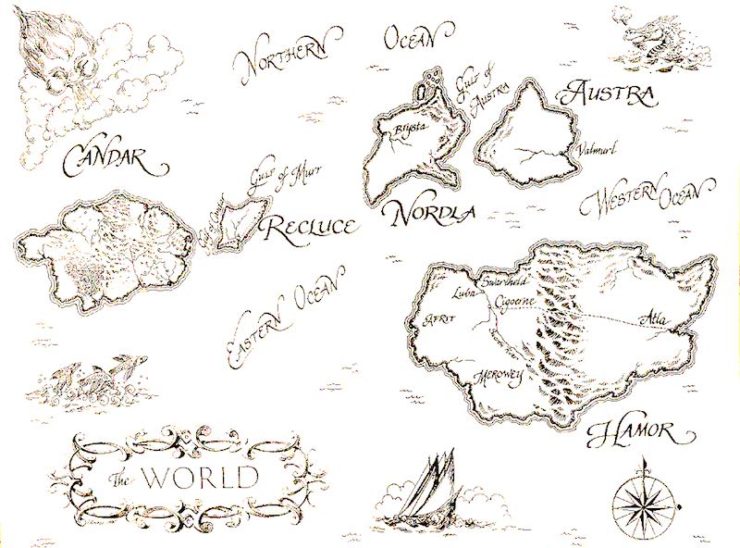
Now I have to add 19 more books to my “to-read” list. LOL
Hello,
I run the Recluce Mapping Project . It is an animated map that shows the travels of the main character as they travel through their story. It is powered by a wiki backend, so points along the map are updated and improved by the users.
Here is an example
Far and away my favorite fantasy series. Protagonists are youngsters, oldsters, men, women, and the magical system is extremely well thought out. Neither Order not Chaos are one-trick ponies and how each master can demonstrate their power is very interesting.
Places to start that keep things understandable and approachable: Fall of Angels/Chaos Balance, Magii of Cyador/Scion of Cyador, White Order/Colors of Chaos (interestingly, you get the ‘enemy’ perspective by reading Magic Engineer).
I haven’t read this series since. recluse first came out but these posts are intriguing. I keep seeing thus quote when reading order is discussed “the only caveat being that one should read the first book of a certain character before going on to the second”. So it would be really helpful if you can note which are the multi-book characters and which books they’re in!
@yuri.
The first four books are all singletons, then Lerris gets a second outing in The Death of Chaos.
From Fall of Angels onwards he started writing consecutive pairs – Fall of Angels/The Chaos Balance, The White Order/Colors of Chaos and so on with each pair wrapping up that character’s story. The only standalone there is Arms-Commander, and that is mostly a follow on from The Chaos Balance.
The series can generally be read in any order, but each pair makes more sense to be read in publishing order as Modesitt does a minimum of repeating the previous plots so you’d miss a fair bit of the backstory.
I colorized Candar map and suppressed some themes for readability of towns when searching. The other features are readable if you are looking for them. I use color for information content more than aesthetics, though I also try for that. I added a few towns based on my estimates from reading, added Analeria as a grassland and added a river between the Corum and Jellicor River to match text. Had to shift a few towns slightly to make room. Added river and other feature labels as I could. I make no copyright claims and pass my regards to the original artist. I am just trying to make things easier to follow while reading the books.
By the way, is the town of Frven the location of the ruins of Fairhaven?
I would have inserted this map, but there appears to be no way to upload a map directly from my computer. If there is, please provide instructions.